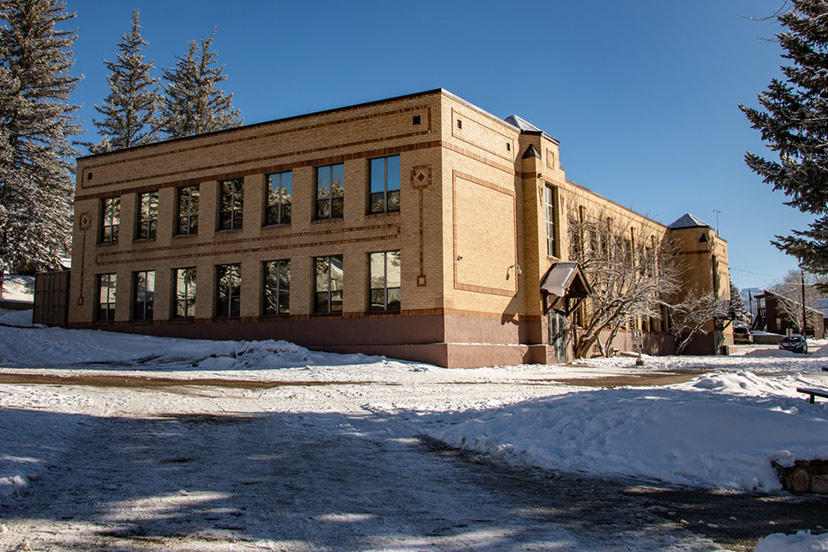Photo: Pagosa Springs Middle School, 5th & 6th Grade Building, originally built in 1928.
The question posed in Part One: If a government has lost the trust of the taxpayers, can it gain the trust back?
And how might that happen?
The Archuleta Board of County Commissioners held a lengthy work session on Tuesday, to hear from the various County departments about their budget requests for 2025. I sat through a few of the discussions, but not all. The questions from the commissioners were thoughtful, though generally mild-mannered. I was left with the impression that most of the budget lines would either remain the same as in the 2024 budget, or else increase by exactly 2%, which was apparently the standard increase favored by the BOCC, in an environment of steady inflation.
A budget that can begin the process of regaining the public’s trust?
I’m thinking back to 2011. Archuleta School District (ASD) had been growing its student enrollment by leaps and bounds through the 1990s and on into 2008, when the Great Recession hit Pagosa’s construction and real estate industries, and the District’s enrollment declined for the first time in 20 years.
At the same time, the state of Colorado was trying to resuscitate the economy, and one of the tactics was to tear down older school buildings and build brand-new “21st Century” buildings. (Despite the lack of any evidence that students learn any better in new buildings.). The state had created the BEST program (“Building Excellent Schools Today”) and began handing out millions of dollars to school districts willing to help keep big, Front-Range construction companies busy. And maybe a few local subcontractors, too?
To facilitate the demolition of school buildings — or so it seemed — the Colorado Department of Education (CDE) sent inspectors around the state, documenting the poor state of educational facilities, and calculating what it might cost to bring those older buildings up to “standards” necessary for successful education to take place.
All of the buildings in Pagosa Springs needed major repairs, partly because of deferred maintenance and a string, perhaps, of incompetent facility managers and short-sighted budget decisions.
The school with the most serious physical deficiencies, oddly enough, was the relatively-new High School, built in 1998.
And the school in the best shape was the Middle School 5th & 6th grade facility… the old brick building on Lewis Street, built in 1924. (They don’t build them like they used to.)
Armed with those CDE “condition” surveys, ASD convened a meeting of local government officials and prominent business owners, and presented a plan to abandon Pagosa Springs Elementary School and Pagosa Springs Middle School, and build a new “mega-campus” on a rocky hillside adjacent to the High School. Our local leadership was enthusiastic, especially since both property tax and sales tax revenues were down… and by god, wasn’t there something we could do to get people’s spirits lifted up?
How about a school bond — up to $98 million — funded by a property tax increase, for starters? That ought to get people excited.
Personally, I was not excited by the prospect of tearing down 50-year-old school buildings and paying $98 million to start from scratch, on a rocky hillside. But many local officials were excited… especially, the School Board.
I was also disappointed, as were many others, by the then-District Superintendent’s willingness to spread what we considered misinformation.
The proposed bond measure lost by a 3-to-1 margin, as ASD lost the trust of the community.
Five years later, a fresh team of volunteer School Board members and a new Superintendent decided to make another try at passing a bond measure. Unlike the effort in 2012, which an been an futile exercise in forcing a tax increase down the community’s throat, the School Board decided to more people involved in the planning process. Numerous planning meetings involving dozens of community members were held; a consultant was hired to facilitate the planning discussions.
Then something rather remarkable happened. The community planning group recommended to the School Board that they not move forward with a bond for new facilities, but rather, that they ask the voters for a much smaller “Mill Levy Override” to increase safety and security in the existing buildings.
The voters approved the MLO by nearly a 2-to-1 margin.
ASD had regained the community’s trust. Five years later, a measure to renew the MLO passed easily.
Tonight at 6pm, at the Pagosa Springs Elementary School, ASD Superintendent Rick Holt and his staff will present ideas about how to deal with the deferred maintenance on school facilities that are now 12 years older than they were in 2012.
Enrollment lately has been flat, so ASD can’t easily justify new schools on the basis of “overcrowding”. But CDE came through town again, last summer, and wrote up new “condition reports” on the buildings, so we will possibly hear something about that at the presentation.
We might wonder why ASD has recently been successful — twice, since 2017 — in getting the voters to approve a tax increase, and why Archuleta County has recently failed — three times, since 2017 — to pass a tax increase.
Different levels of community involvement?
Smaller, more tolerable tax increases vs. large tax increases?
Clear vs. unclear descriptions about how the money will be used?
Trust issues?

